高二英语师大选择性必修一Unit 3 conservation 2教学设计
- 格式:doc
- 大小:27.50 KB
- 文档页数:2

北师大2019版教材教学设计选择性必修第一册Unit 3 Conservation Lesson 3 The Road to Destruction(第1课时)文本分析What本节课的教学内容第一部分是关于英国汽车使用的现状和过度的汽车使用对环境造成的致命影响;第二部分是介绍了专家给出的五点绿色出行建议。
本节课还补充了一篇中国政府为解决城市交通问题和为打赢蓝天保卫战所采取的措施的英文阅读文章。
Why随着社会的快速发展,人们对汽车的依赖性是越来越强。
汽车的过度使用对路面交通和环境带来巨大的问题,特别是因为交通和空气污染死亡的人数也越来越多。
人类必须重视此问题,并做出改变。
这也是本课毁灭之路的教学目的。
为了把英国和中国的共同汽车问题进行文化对比,本节课还加入一篇互文阅读文章。
How本课通过对话和第一人称的写作手法展示文本话题的普遍性和真实性。
在说明汽车过度使用危害的时候列举了大量数据以证明危害之大。
文本的写作风格很口语化,语言和句式也很简单明了。
正是因为本文阅读对于学生没有任何挑战,所以本节课加入了一篇中国相关问题的文章,以便培养学生的文化意识。
学情分析学生基本状况:上课班级为高二年级学生,学生们的英语学习热情较高,英语水平在同年级里相对很突出,能够主动思考和善于提问,喜欢合作讨论,课堂气氛活跃,但是关于英国汽车的使用状况以及汽车对环境造成的破坏程度背景知识了解甚少。
通过阅读文本,学生们会很快了解这些事实性信息。
教学目标在本课结束时,学生能够:1.获取英国汽车使用的数据呈现以及过度使用汽车所带来的恶果等事实性信息;2.提取英国环保专家所倡导的个人绿色出行建议及益处;3.获取中国政府为解决城市交通问题和为打赢蓝天保卫战所采取的措施;4.以己之长,用己所学写一封信,体现公民的社会担当。
教学重点学生在阅读完英国汽车使用的现状和所带来的系列问题之后,能够提取出互文阅读文本中中国政府在相关问题上所采取的有效措施。
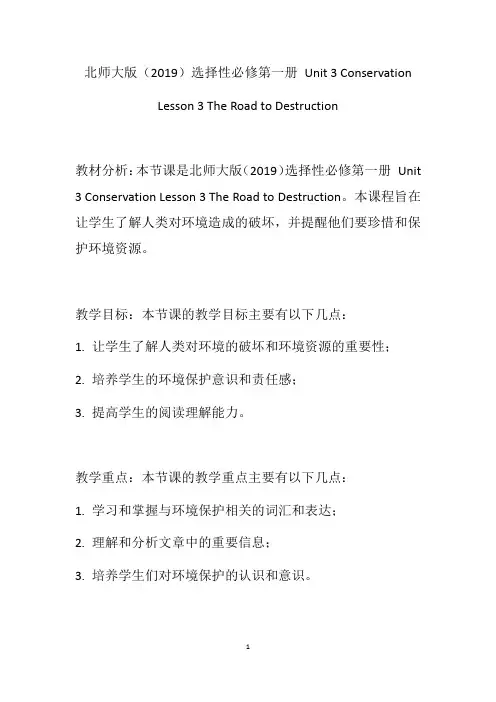
北师大版(2019)选择性必修第一册Unit 3 ConservationLesson 3 The Road to Destruction教材分析:本节课是北师大版(2019)选择性必修第一册Unit 3 Conservation Lesson 3 The Road to Destruction。
本课程旨在让学生了解人类对环境造成的破坏,并提醒他们要珍惜和保护环境资源。
教学目标:本节课的教学目标主要有以下几点:1. 让学生了解人类对环境的破坏和环境资源的重要性;2. 培养学生的环境保护意识和责任感;3. 提高学生的阅读理解能力。
教学重点:本节课的教学重点主要有以下几点:1. 学习和掌握与环境保护相关的词汇和表达;2. 理解和分析文章中的重要信息;3. 培养学生们对环境保护的认识和意识。
教学难点:本节课的教学难点主要有以下几点:1. 理解和活用文章中的复杂词汇和句子;2. 提高学生的阅读解题能力,培养学生的分析思考能力。
学情分析:学生作为高一学生,英语水平普遍较高,基本词汇和语法已经掌握。
然而,他们对环境问题的认识可能还比较浅薄,缺乏深入的思考和分析能力。
因此,教师需要以生动有趣的方式引导学生深入思考和讨论环境保护问题。
教学策略:教师可以通过引入相关图片、视频和真实案例等教学材料来激发学生的学习兴趣,让学生在情境中体验环境问题的严重性。
教师还可以结合小组讨论、角色扮演和问题解决等活动,培养学生的团队合作和创新思维能力。
教学方法:本节课可以采用多种教学方法,如听说读写综合训练、阅读理解训练、小组合作讨论、信息搜集和归纳总结等。
通过多元化的教学方式,可以提高学生的学习效果和兴趣,帮助他们更好地理解和运用所学知识。
教学过程如下:导入环节(约5分钟):1. 引入话题:先向学生简要介绍本节课的主题——《The Road to Destruction》(《毁灭之路》),并与他们分享一个相关的真实故事或新闻,引起学生的兴趣和思考。
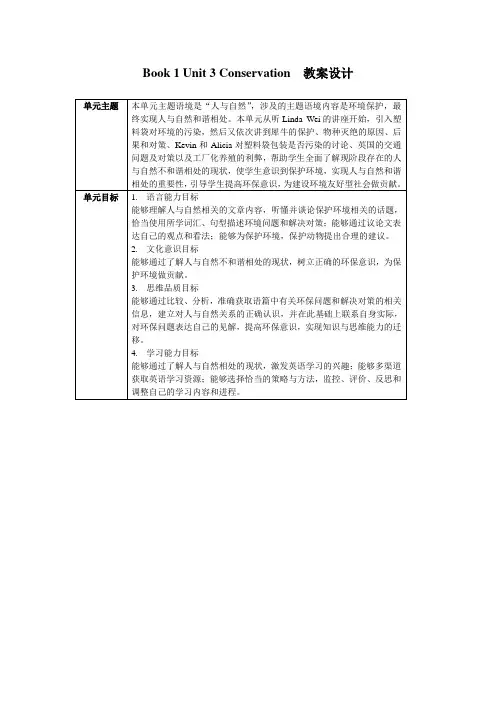
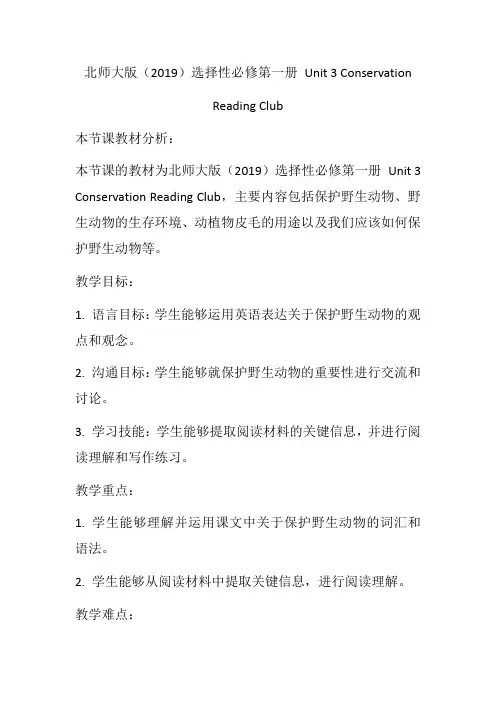
北师大版(2019)选择性必修第一册Unit 3 ConservationReading Club本节课教材分析:本节课的教材为北师大版(2019)选择性必修第一册Unit 3 Conservation Reading Club,主要内容包括保护野生动物、野生动物的生存环境、动植物皮毛的用途以及我们应该如何保护野生动物等。
教学目标:1. 语言目标:学生能够运用英语表达关于保护野生动物的观点和观念。
2. 沟通目标:学生能够就保护野生动物的重要性进行交流和讨论。
3. 学习技能:学生能够提取阅读材料的关键信息,并进行阅读理解和写作练习。
教学重点:1. 学生能够理解并运用课文中关于保护野生动物的词汇和语法。
2. 学生能够从阅读材料中提取关键信息,进行阅读理解。
教学难点:1. 学生能够运用所学知识和语言进行交流,表达自己的观点和观念。
2. 学生能够理解并运用课文中较难的词汇和句式。
学情分析:学生是高一学生,英语水平相对较低,对于保护野生动物可能了解不多,也缺乏相关的词汇和语法知识。
此外,学生的阅读理解能力和写作能力也还需要提高。
因此,在教学过程中需要注重培养学生的语言运用能力、沟通能力和阅读理解能力。
教学策略:1. 激发学生的学习兴趣,通过展示有关野生动物保护的图片和视频来引导学生思考和讨论。
2. 创设真实情境,让学生参与到保护野生动物的讨论和问题解决中,提高学生的主动学习和动手能力。
3. 引导学生运用所学的语言知识和技能进行口头交流和写作练习。
教学方法:1. 任务型教学法:通过完成一系列的任务和活动,培养学生的语言运用能力和沟通能力。
2. 合作学习法:组织学生进行小组讨论和合作活动,提高学生的合作意识和团队精神。
3. 情景教学法:通过创设真实情境,激发学生的学习兴趣和动机,提高学生的学习效果。
4. 多媒体辅助教学法:利用多媒体资源,如图片、视频等辅助教学,提高学生的学习效果和理解能力。
导入环节(约5分钟)教学内容:1. 导入学生对保护自然和环境的认识和观点。
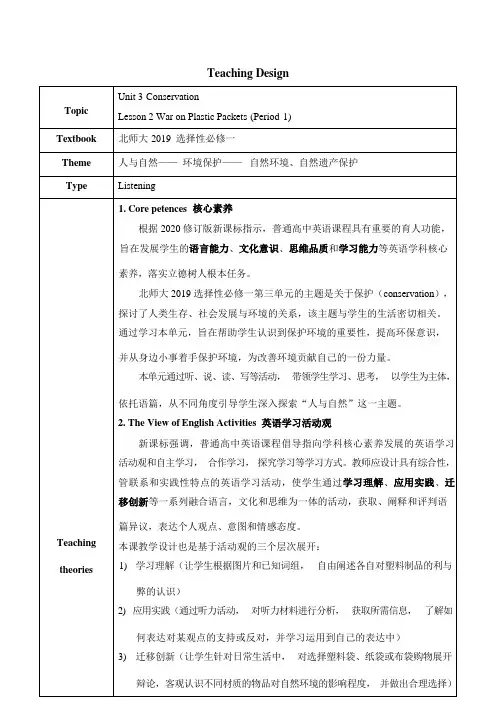
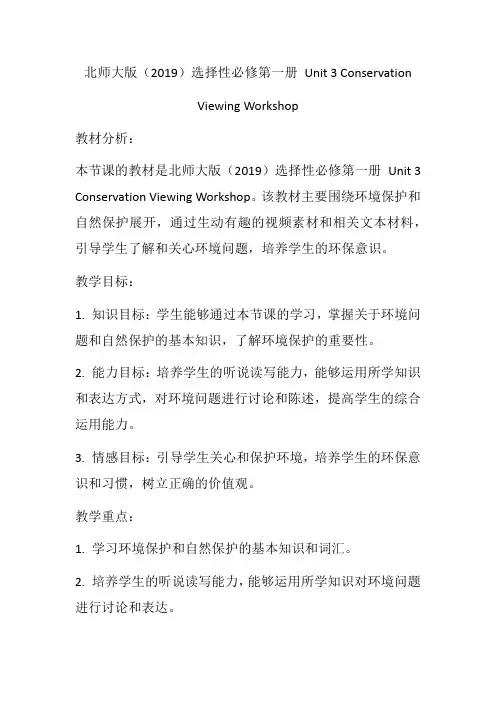
北师大版(2019)选择性必修第一册Unit 3 ConservationViewing Workshop教材分析:本节课的教材是北师大版(2019)选择性必修第一册Unit 3 Conservation Viewing Workshop。
该教材主要围绕环境保护和自然保护展开,通过生动有趣的视频素材和相关文本材料,引导学生了解和关心环境问题,培养学生的环保意识。
教学目标:1. 知识目标:学生能够通过本节课的学习,掌握关于环境问题和自然保护的基本知识,了解环境保护的重要性。
2. 能力目标:培养学生的听说读写能力,能够运用所学知识和表达方式,对环境问题进行讨论和陈述,提高学生的综合运用能力。
3. 情感目标:引导学生关心和保护环境,培养学生的环保意识和习惯,树立正确的价值观。
教学重点:1. 学习环境保护和自然保护的基本知识和词汇。
2. 培养学生的听说读写能力,能够运用所学知识对环境问题进行讨论和表达。
教学难点:1. 培养学生的综合运用能力,能够运用所学知识和表达方式对环境问题进行讨论和陈述。
2. 激发学生的学习兴趣,引导学生关心和保护环境。
学情分析:学生是高一学生,具有一定的英语基础。
学生对环境问题可能有一定的了解,但对于环境保护和自然保护的相关知识可能还比较陌生。
学生活跃性高,善于合作和分享。
但由于课时有限,需要合理安排时间,确保学生能够充分参与课堂活动。
教学策略:1. 激发学生的学习兴趣:通过展示生动有趣的视频素材和相关图片,引发学生的好奇心,激发学生去了解和关心环境问题。
2. 引导学生的自主学习:设计任务型活动,让学生在小组中进行合作探究,培养学生的团队合作精神和主动思考能力。
3. 提供实践机会:通过组织辩论、小组讨论和角色扮演等活动,帮助学生运用所学知识进行实践,提高语言表达能力。
教学方法:1. 视听教学法:结合视频素材和图片,进行视听语言输入和输出训练,提高学生的听说能力。
2. 任务型教学法:设计任务型活动,引导学生在探究中学习,培养学生的自主学习能力和合作意识。
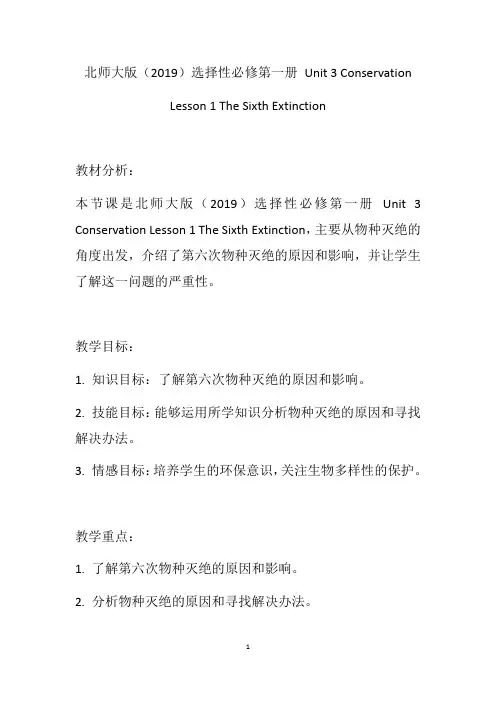
北师大版(2019)选择性必修第一册Unit 3 ConservationLesson 1 The Sixth Extinction教材分析:本节课是北师大版(2019)选择性必修第一册Unit 3 Conservation Lesson 1 The Sixth Extinction,主要从物种灭绝的角度出发,介绍了第六次物种灭绝的原因和影响,并让学生了解这一问题的严重性。
教学目标:1. 知识目标:了解第六次物种灭绝的原因和影响。
2. 技能目标:能够运用所学知识分析物种灭绝的原因和寻找解决办法。
3. 情感目标:培养学生的环保意识,关注生物多样性的保护。
教学重点:1. 了解第六次物种灭绝的原因和影响。
2. 分析物种灭绝的原因和寻找解决办法。
教学难点:1. 分析物种灭绝的原因和寻找解决办法。
2. 培养学生的环保意识,关注生物多样性的保护。
学情分析:学生为高一学生,他们的英语水平一般较为基础,因此在教学过程中需要考虑到学生的接受能力和理解能力。
同时,学生对环境问题和生物多样性的保护可能有一定的了解,但对物种灭绝的具体原因和解决办法可能还不太清楚。
教学策略:1. 激发学生的学习兴趣,例如通过引入一些有趣的例子和图片,让学生更好地理解物种灭绝的严重性。
2. 创设情境,让学生进行交流和合作,激发他们的思考和分析能力。
3. 鼓励学生多角度思考问题,并引导他们思考物种灭绝的根本原因和解决办法。
教学方法:1. 预习导入:通过展示一些受威胁物种的图片,激发学生的学习兴趣,并引发他们对于物种灭绝的思考。
2. 组织小组讨论:将学生分组进行讨论,使他们能够从不同的角度思考物种灭绝的原因和解决办法,并进行分享。
3. 师生互动:教师发问,学生回答,通过互动交流,检查学生对于所学内容的掌握程度,并澄清疑惑。
4. 案例分析:以现实案例为例,让学生从具体的问题中感受到物种灭绝的严重性,并思考如何应对。
导入环节(约5分钟):教学内容:介绍生物多样性和生物灭绝的概念。
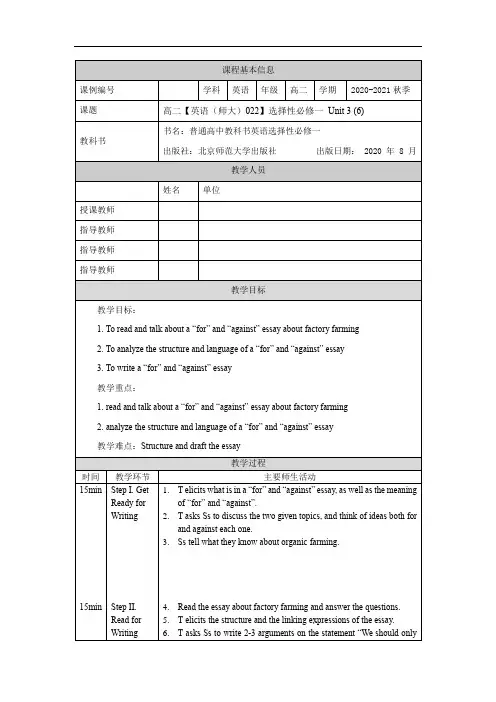
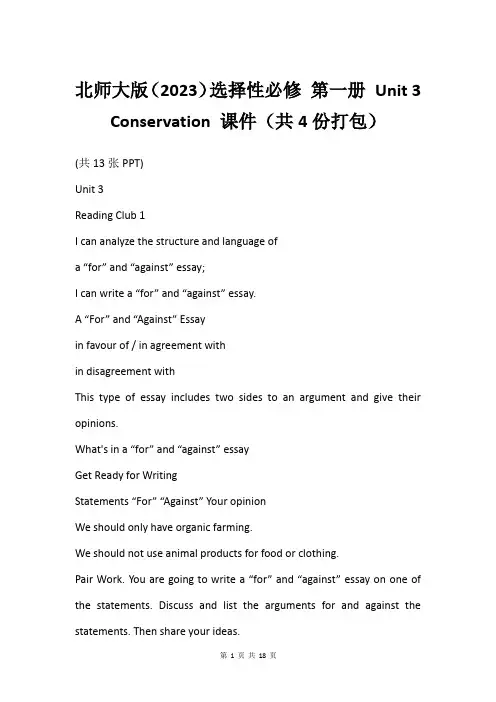
北师大版(2023)选择性必修第一册Unit 3 Conservation 课件(共4份打包)(共13张PPT)Unit 3Reading Club 1I can analyze the structure and language ofa “for” and “against” essay;I can write a “for” and “against” essay.A “For” and “Against” Essayin favour of / in agreement within disagreement withThis type of essay includes two sides to an argument and give their opinions.What's in a “for” and “against” essayGet Ready for WritingStatements “For” “Against” Your opinionWe should only have organic farming.We should not use animal products for food or clothing.Pair Work. You are going to write a “for” and “against” essay on one of the statements. Discuss and list the arguments for and against the statements. Then share your ideas.1organic farmingfactory farmingVSWhat is your opinionWhat is organic farmingnumerous ecological benefitshigher quality and nutritional valuehigher food costsWhat do you know about factory farmingmass production of meat or eggsfood at lower costsrely heavily on chemicals1. What is the main topic of the essay2. What are the main arguments and supporting details used “for” and “against” factory farming3. What is the writer’s opinion about factory farmingThe pros and cons of factory farming.We should try to reduce this kind of farming, although we would have to pay more for our eggs and meat.“For”: Apart from being a lot cheaper than organic farming, it provides more food for a world population that has already reached seven billion.“Against”: Opponents of factory farming say that it is cruel to the animals.a person who disagrees with sth. and speaks against it2Read the essay. Answer the questions3Read the essay again. Match the functions to each paragraph.a. conclusion (your opinion)b. arguments against the topicc. introduction to the topicd. arguments for the topicPara. 1 _____Para. 2 _____Para. 3 _____Para. 4 _____cdbaaccording toAccording to an institute, “74% of the world's poultry… are produced in this way”.moreoverMoreover, factory-farmed animals suffer from fewer diseases…on the other handOn the other hand, opponents of factory farming say that it is cruel to the animals.Sentence Builderfor instanceFor instance, many farm animals are kept in small spaces where they can hardly move.in addition toIn addition to this, factory farming has a negative impact on the environment.in my opinionIn my opinion, we should try to reduce this kind of farming, although we would have to pay more for our eggs and meat.Linking Expressions1 summarising information2 adding new information3 giving examples4 providing sources of information5 contrasting statementsWhich of the linking expressions in the Sentence Builder has the following functionin my opinionmoreover/ in addition tofor instanceaccording toon the other hand4Write 2-3 arguments on the statement “we should only have organic farming.” or “we shouldn’t use any animal products for food or clothing.” Use the Sentence Builder to help you.5We should only have organic farming.1. according to2. moreover3. in addition to4. on the other hand5. for instance6. in my opinionArgument 1:Argument 2:“We should only have organic farming.”Argument 1: According to a recent study, food produced by organic farming is of higher quality and more nutritious than food we usually see on the market.Argument 2: Moreover, organic farming leaves the earth in its natural state after harvest.Argument 3: On the other hand, opponents of organic farming say thatorganic foods are often higher in cost, and many families simply cannot afford the cost.“We should not use any animal products for food or clothing.”Argument 1: According to a recent study, the production of wool, fur, and leather contributes to climate change, land devastation and water pollution.Argument 2: In addition, raising and killing animals for food is morally wrong; eating animals means a clear violation of their fundamental right to life.Argument 3: On the other hand, we still need some domestic animals such as chickens and ducks to supply our daily diet and nutrition.6plete the outline of your essay on the statement you have chosen based on Activity 3.体裁话题时态人称文章架构议论文Argumentative Writing以一般现在时为主;以第三人称为主第一段:引出话题We should only have organic farming.第二段:支持者的观点第三段:反对者的观点尾段:自己的观点Expressing Both Sidespros and consadvantages and disadvantages plus and minusProviding Additional Arguments What is moreIn addition to … the …Further,Not only will…, but … will also…Showing Contrast However,On the other hand, Although…Unfortunately,OrderingFirst of all,Then,Next,Finally,SummarizingTo sum up,In conclusion,In summary,All things considered,Expressing Your OpinionIn my opinion,I feel / think that…Personally,Introduction to the topic: Organic farming is the production of food using all natural methods with “zero” impact on the environment. Arguments for the topic: According to a recent study...; For instance... Arguments against the topic: On the other hand...; In addition to this... Conclusion (your opinion): We should encourage organic farming although…Compose Your WritingDrafting. Use your outline and the Writing Help to write your first draft. Writing HelpWriting a “For” and “Against” EssayIt’s important to:have a clear argument statement;include “for” and “against” opinions;support your own opinion with examples and other details;sum up your argument in the final paragraph.7Editing. Edit your essay in pairs. Then share what you have written in class.Does the writer give a clear statement “for” or “against” the issueDoes the structure flow well (statement, main argument with supporting details, other arguments and conclusion)Does the writer use a variety of linking expressionsDo you feel that the writer has a strong belief in the argument he / she is presentingEditing Sheet8暑假即将来临,你班同学就假期计划进行了讨论,并提出了不同的看法,请根据提示写一篇英语短文,谈谈你的看法。
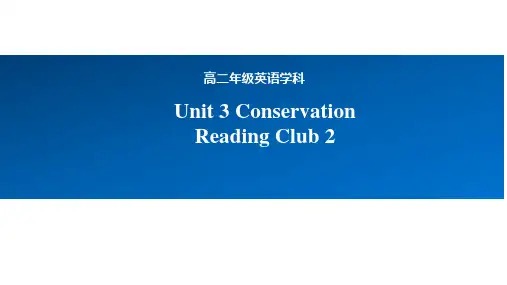
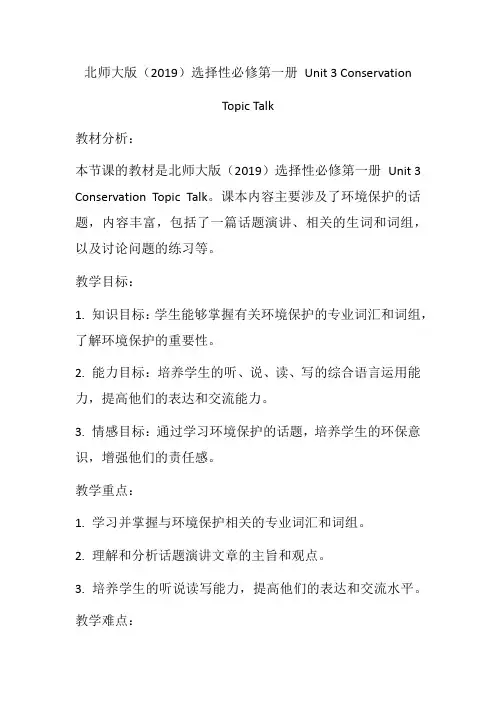
北师大版(2019)选择性必修第一册Unit 3 ConservationTopic Talk教材分析:本节课的教材是北师大版(2019)选择性必修第一册Unit 3 Conservation Topic Talk。
课本内容主要涉及了环境保护的话题,内容丰富,包括了一篇话题演讲、相关的生词和词组,以及讨论问题的练习等。
教学目标:1. 知识目标:学生能够掌握有关环境保护的专业词汇和词组,了解环境保护的重要性。
2. 能力目标:培养学生的听、说、读、写的综合语言运用能力,提高他们的表达和交流能力。
3. 情感目标:通过学习环境保护的话题,培养学生的环保意识,增强他们的责任感。
教学重点:1. 学习并掌握与环境保护相关的专业词汇和词组。
2. 理解和分析话题演讲文章的主旨和观点。
3. 培养学生的听说读写能力,提高他们的表达和交流水平。
教学难点:1. 提升学生的英语听和读的能力,使他们能够理解文章的主旨和观点。
2. 培养学生的写作能力,使他们能够准确、流畅地表达自己的思想。
学情分析:学生是高一年级的学生,具有一定的英语基础,能够较好地理解和运用英语。
但是他们对于环境保护的知识和专业术语可能不太熟悉,对于演讲文章的理解和写作能力有待提高。
教学策略:1. 激发学生学习兴趣:通过引入真实案例、音频和视频等多媒体素材,激发学生的学习兴趣,增强他们的学习动力。
2. 情景教学:通过模拟环境保护的实际场景,让学生在情境中体验,增强他们对环保的认识和理解。
3. 合作学习:通过小组讨论、合作学习等方式,培养学生的交流和合作能力,激发他们的团队合作精神。
教学方法:1. 预习导入:通过播放相关视频、展示环境保护图片等方式,引入环境保护话题,唤起学生的相关思维,激发学习兴趣。
2. 听说训练:通过播放录音材料和集体朗读的方式,训练学生的听说能力,提高他们对文章主旨和观点的理解。
3. 课堂练习与讨论:通过课后练习题和小组讨论的方式,巩固学生的学习成果,加深对专业术语和文章内容的理解。
UNIT 3 CONSERVATION第一部分阅读(50分)第一节(共15小题,每题2.5分,37.5分)AGiven Europe’s high concentration of gorgeous big cities and worldclass art museums, it is easy to completely overlook the continent’s abundance of small, quiet villages and towns. However, if you are after relaxation, peaceful country walks, beautiful architecture and opportunities for cultural appreciation on your next trip across the pond, consider cutting down some of your city time and head out to a village instead. Here are four of the most charming villages in Europe, along with our top picks for places to stay in each.Eze in Cota D’Azur, FranceSet on a hilltop overlooking the Mediterranean Sea, the Provencal township of Eze is easily one of the most picturesque spots in the region. It is largely a tourist destination, and many of its buildings dates back to the Middle Age. In fact, Eze is particularly popular with couples seeking romantic solitude.Hotel pick: Chateau de la ChevreBadenBaden in Wurttemberg, GermanyGermany’s bestknown spa town, BadenBaden, in the Black Forest of BadenWurttemberg, has been a popular spot for soaking in mineralrich waters off and on since the Roman era. And whilespa treatments and hot springs are still among the most popular draws for tourists, there are also plenty of museums, gardens, performing arts venues and charming old buildings and churches.Hotel pick: Hotel Belle EpoqueMontepulciano in Tuscany, ItalySpread over a hilltop nearly 2,000 metres above sea level, the Tuscan village of Montepulciano offers gorgeous Renaissance architecture as well as opportunities to visit wine companies. Surrounded by strong walls dating back to the 14th century, the village features a handful of churches and public squares.Hotel pick: Etruria ResortOia in Santorini, GreeceOia is undoubtedly the most charming village on the beautiful Greek island of Santorini. This oftphotographed cliffside town is best known as a sunsetviewing spot, but it is fantastic any time of day thanks to its abundance of typical whitewashed structures topped with blue domes plus its fabulous views out onto the Aegean Sea.Hotel pick: Hotel Aspaki1.Which village will newlymarried couples most possibly choose to spend their honeymoon?A.Oia. B.BadenBaden.C.Montepulciano. D.Eze.2.The visit to Montepulciano will be different from to otherthree because ________.A.you can appreciate Renaissance architectureB.you can enjoy a beautiful sunset viewC.you can have a spa treatmentD.you can overlook Mediterranean Sea3.You probably find this passage in ________.A.Times B.National GeographicC.Readers’ Digest D.Economist【语篇解读】本文为说明文。
Unit 2 SuccessLesson 1 Money Vs Success学习目标掌握本节生词及句型表达与运用。
词汇运用1、appreciateP31 But Jason appreciates this change.但是詹森喜欢这种变化。
知识点讲解:(1)vt. 欣赏,赏识You can't really appreciate foreign literature in translation.看翻译作品不能真正欣赏到外国文学原著的美妙之处。
(2)感激,感谢appreciate(sb./sb.’s)doing…感激(某人)做……I would appreciate it if… (=I would be grateful if.) 如果……我将不胜感激。
we would appreciate you/your letting us know of any problems.有任何问题请告诉我们,我们将不胜感激。
(3)vt. 理解,意识到,领会He didn't fully appreciate the significance of signing the contract.他没有完全理解签署这份合同的意义。
练习:(1). Those who are middle-aged can appreciate the importance of good health.A.to be grateful for sth. that sb. has doneB.to understand that sth.is trueC.to recognize the good qualities of sb./sth.(2). 语法填空①I’d appreciate if you would like to teach me how to use the expression once more and I always appreciate you (help) me with my English in thepast.②I appreciate (give) the opportunity to work in your company.③In this letter, I would like to convey my sincere (appreciate) to you for your help.参考答案:(1). ①C②A③B (2). ①it;helping ②being given ③appreciation 2、give awayP31 He made the choice to give all his money away.他决定把自己的钱财都捐赠出去。